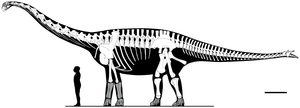Spinophorosaurus
| Spinophorosaurus | ||||||||||
|---|---|---|---|---|---|---|---|---|---|---|

Spinophorosaurus nigerensis , skeletal reconstruction (from Remes et al., 2009) |
||||||||||
| Temporal occurrence | ||||||||||
| possibly Middle Jurassic ( Bajocian to Bathonian ) | ||||||||||
| 170.3 to 166.1 million years | ||||||||||
| Locations | ||||||||||
|
||||||||||
| Systematics | ||||||||||
|
||||||||||
| Scientific name | ||||||||||
| Spinophorosaurus | ||||||||||
| Remes et al. , 2009 | ||||||||||
| Art | ||||||||||
|

Spinophorosaurus is a genus of early sauropod dinosaurs . So far, two incomplete skeletons are known from the Central Jurassic of Africa, which werescientifically described in2009 with the so far only species Spinophorosaurus nigerensis .
Spinophorosaurus is the best known basal sauropod outside of the Eusauropoda and is therefore of great importance for understanding the early evolution of the sauropods. Like the related Shunosaurus, this genus was characterized by osteodermal spiked weapons at the end of the tail.
features
The type skeleton is estimated to have a total length of 13 meters, but belonged to a subadult, i.e. not yet fully grown animal, as some of the cranial and vertebral sutures were not yet fused. The second skeleton was about 13% larger, with fully fused vertebral sutures indicating a fully grown animal.
The teeth are characterized by large denticles (small, sawtooth-like projections) with an increased distance from one another. The spine consists of 13 cervical, 12 back, 4 sacral and over 37 caudal vertebrae. The cervical vertebrae are moderately elongated and show large lateral cavities at the centers (pleurocoels). Towards the posterior vertebrae, the pleurocoels become weaker and weaker, while the vertebral centers become shorter relative to the height. Two closely connected skin bones (osteoderms) were found in the holotype skeleton, which are concave on the inside and point upwards with a spike. These 29 cm long structures were found in the pelvic region of the skeleton, but probably sat at the rear end of the tail in the living animal. Similar tail weapons are also found in the related Shunosaurus .
Autapomorphies , i.e. features by which the genus can be distinguished from related genera, can be found on various elements of the skeleton. The coracoid , for example, was kidney-shaped. Furthermore, the rear chevron bones overlapped and thus formed rod-like structures running horizontally.
Finds and naming
So far, two incomplete skeletons are known that were discovered north of Aderbissinat ( Agadez region , Niger ). The first skeleton ( holotype , copy numbers GCP-CV-4229 and NMB-1699-R) consists of cranial bones ( brain skull , postorbital , squamosum , square bone , pterygoid and surangular ) as well as an almost complete residual skeleton (postcranium), in which only the sternum , the forearm, finger and foot bones are missing. While GCP-CV-4229 is temporarily kept in the Museo Paleontológico de Elché in Spain, NMB-1699-R is in the Natural History Museum in Braunschweig . In the future, the entire skeleton is to be given to the Musee National d'Histoire Naturelle in Niamey (Niger). Another find (Paratyp, NMB-1698-R) - an incomplete skull and an incomplete postcranium - shows not only bones that are already known from the holotype skeleton, but also other skeletal elements that are not preserved in the latter ( premaxillary , maxilla , Lacrimal , dental , angular , dorsal ribs, humerus , as well as a single toe bone).
Stratigraphically , the site belongs to the base of the Irhazer group , the exact age of which is not known. The finds probably come from the Middle Jurassic ( Bajocian to Bathonian ) - an even older deposition period for the sediments at the site in the Lower Jurassic cannot be ruled out. The skeletons were found 15 meters apart within a several meters thick layer of red siltstone .
The finds were scientifically described in 2009 by researchers from Spain, Germany and Niger . The generic name Spinophorosaurus ( lat. Spina - "sting", Greek phoro - "carry", sauros - "lizard") indicates the large, spiky osteoderms that were probably used as weapons at the end of the tail. The Artepiteth nigerensis points to the country Niger, from which the fossils come.
Phylogeny and paleobiogeography
Spinophorosaurus is the basal sauropod and sister taxon of the Eusauropoda , which includes Shunosaurus and all more modern sauropods. With the discovery of Spinophorosaurus , earlier ideas about the evolution of early sauropods could be questioned and new hypotheses made. The researchers confirm that there was no monophyletic group of East Asian, Central Jurassic sauropods, but that the common features of these East Asian species already appear in much more basal sauropods. Instead, there are greater anatomical differences between Spinophorosaurus and contemporary sauropods from southern Gondwana , from which the researchers conclude that there is a possible monophyletic group of southern Gondwanian Eusauropods. In this context, the researchers contradict the view that the sauropod faunas were uniform worldwide before the break-up of the supercontinent Pangea .
literature
- Kristian Remes, Francisco Ortega, Ignacio Fierro, Ulrich Joger , Ralf Kosma, José Manuel Marín Ferrer: A New Basal Sauropod Dinosaur from the Middle Jurassic of Niger and the Early Evolution of Sauropoda. In: PLoS ONE . Vol. 4, No. 9, 2009, e6924, doi : 10.1371 / journal.pone.0006924 .
Individual evidence
- ^ Gregory S. Paul : The Princeton Field Guide To Dinosaurs. Princeton University Press, Princeton NJ et al. 2010, ISBN 978-0-691-13720-9 , p. 173, online .